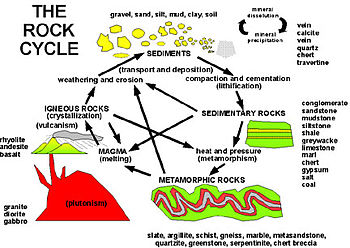| The Rock Cycle is a group of changes. Igneous rock can change into sedimentary rock or into metamorphic rock. Sedimentary rock can change into metamorphic rock or into igneous rock. Metamorphic rock can change into igneous or sedimentary rock.
Igneous rock forms when magma cools and makes crystals. Magma is a hot liquid made of melted minerals. The minerals can form crystals when they cool. Igneous rock can form underground, where the magma cools slowly. Or, igneous rock can form above ground, where the magma cools quickly.
When it pours out on Earth's surface, magma is called lava. Yes, the same liquid rock matter that you see coming out of volcanoes.
On Earth's surface, wind and water can break rock into pieces. They can also carry rock pieces to another place. Usually, the rock pieces, called sediments, drop from the wind or water to make a layer. The layer can be buried under other layers of sediments. After a long time the sediments can be cemented together to make sedimentary rock. In this way, igneous rock can become sedimentary rock.
All rock can be heated. But where does the heat come from? Inside Earth there is heat from pressure (push your hands together very hard and feel the heat). There is heat from friction (rub your hands together and feel the heat). There is also heat from radioactive decay (the process that gives us nuclear power plants that make electricity).
So, what does the heat do to the rock? It bakes the rock.
Baked rock does not melt, but it does change. It forms crystals. If it has crystals already, it forms larger crystals. Because this rock changes, it is called metamorphic. Remember that a caterpillar changes to become a butterfly. That change is called metamorphosis. Metamorphosis can occur in rock when they are heated to 300 to 700 degrees Celsius.
When Earth's tectonic plates move around, they produce heat. When they collide, they build mountains and metamorphose (met-ah-MORE-foes) the rock.
The rock cycle continues. Mountains made of metamorphic rocks can be broken up and washed away by streams. New sediments from these mountains can make new sedimentary rock.
The rock cycle never stops.
Rock cycle
time-consuming transitions through geologic time among the three main rock types: sedimentary, metamorphic, and igneous
The rock cycle is the process by which rocks of one kind change into rocks of another kind.[1]
There are three main kinds of rocks: igneous rock, metamorphic rock, and sedimentary rock. Each of these rocks can change into the other kinds by physical processes: cooling, melting, heat, weathering/erosion, compacting (squeezing tightly together), cementing, and pressure.
When heated deep under ground, rocks become magma (liquid rock). Above ground, it is called lava. Sediment, the particles from rock erosion and weathering, is the basis for sedimentary rock of the future.[2]
Igneous rock is hardened magma, which can happen above or below ground.[1] It can melt into magma, erode into sediment, or be pressed tightly together to become metamorphic.
Metamorphic rock is igneous or sedimentary rock that has been heated and squeezed.[1] It can erode into sediment or melt into magma. It is formed under extreme pressure and temperature deep inside mountain chains.
Sedimentary rock is compacted sediment which can come from any of the other rocks,[1] plus remains of living things. It can erode back into sediment, or be pressurized into metamorphic rock.
These processes can occur in different orders, and the cycle goes on forever. Earth has several processes for changing rocks. Wind and water can create sediment from rocks, and movement of one tectonic plate against another creates enormous heat and pressure which affects rocks greatly.[3] Subduction converts all kinds into magma, which eventually rejoins the cycle as igneous rock.
THE ROCK CYCLE
|

